600 v.C. - 2023
Overview
Arts & Sciences
Borders, Language & Territory
Economy & Technology
Landscape, Environment & Mobility
Meaning & Religion
Migration
Power & Resistance
Subject
Period
Info
A Place on the Planet
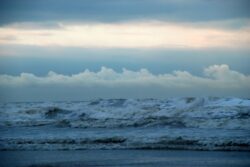
View
12,000 years ago
prehistory
Some 12,000 years ago the last Ice Age ended. The ice-caps melted away and a green blanket of dense forests covered North-West Europe.
Neanderthals in the Valley of the Meuse
The Earliest Traces of Human Habitation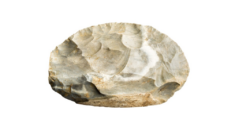
View
c. 500,000
- 33,000 years ago
Prehistory
For thousands of years we, modern humans or homo sapiens, were not the only human species on earth. We shared the world with the Neanderthals.
The Settlement of Rosmeer
The First Farmers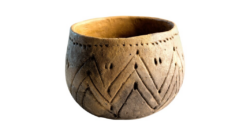
View
c. 5,300
- 4,590 BC
Prehistory
The fertile Haspengouw loamy soils were a magnet for the first farmers, who originated from Eastern Europe.
Celts on the Kemmelberg
Celtic Centralisation of Power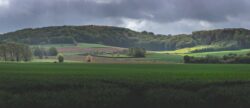
View
c. 800
- 500 BC
Prehistory
Some 2,500 years ago, from their fortified hilltop headquarters on the Kemmelberg, Celtic nobles dominated the surrounding region both literally and figuratively.
Tongeren, a Roman Town
Romanisation of the Low Countries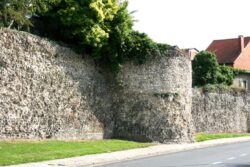
View
c. 10 BC
- 400 AD
Classical Antiquity
Tongeren, the first town in the territory of present-day Flanders, had several kilometres of town walls, an aqueduct and stone buildings in a style that blended local and Mediterranean influences.
Charlemagne
The FranksView
c. 747
- 814
Middle Ages
In Rome, on Christmas Day in the year 800, Pope Leo III crowned the Frankish king Charlemagne Emperor.
Hebban olla vogala
Traces of the Earliest Dutch
View
End of 11th century
Middle Ages
‘Hebban olla vogala nestas hagunnan hinase hic ande thu. Wat unbidan we nu?’ These scribbles on the last page of a manuscript containing Old English sermons are the oldest lines of poetry in Dutch.
The Windmill of Wormhout
Innovation in AgricultureView
c. 1183
Middle Ages
‘In Wormhout [there is] a mill that is propelled by the wind,’ we read in a deed of the count of Flanders from about 1183. It is one of the very earliest mentions of a windmill in the North Sea area.
The Lost Harbours of the Zwin
Bruges, Linked to the Sea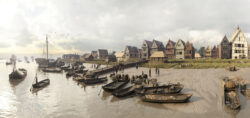
View
c. 1100
- 1500
Middle Ages
Mude, Hoeke or Monnikerede. Those names do not mean much to us today, but in the Middle Ages they were bustling harbour towns along a tidal channel of the North Sea: the Zwin.
Towns on the Map of Al-Idrisi
Contacts with the Muslim World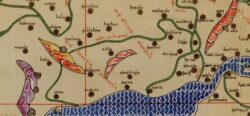
View
c. 1154
Middle Ages
‘Kent’ (Ghent), ‘Abrugs’ (Bruges), ‘Sant Mir’ (Saint-Omer)… Under those corrupt names various Flemish towns appeared on a map of the 12th century. Muhammad Al-Idrisi achieved a considerable feat.
Béguinages
Women Join Forces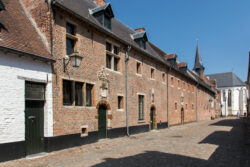
View
13th century
Middle Ages
Today béguinages (begijnhoven) are oases of calm in many towns. The oldest date back to the 13th century. From the late 12th century on groups of unmarried religious women, called béguines, started to live together in towns.
Reynard the Fox
Literature in the Vernacular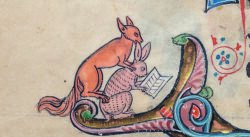
View
c. 1260
Middle Ages
In around 1260 a certain Willem, about whom little else is known, wrote a story in verse about the sly fox Reynard. Vanden vos Reynaerde is one of the oldest texts in Dutch.
1302
Social Revolutions in the Towns of Flanders and Brabant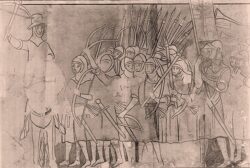
View
1302
Middle Ages
In the early morning of 18 May 1302 rebellious townspeople entered Bruges by stealth. They murdered the French garrison that was stationed there to keep unruly Flanders under control.
The Adoration of the Mystic Lamb by the Van Eyck Brothers
Medieval Iconography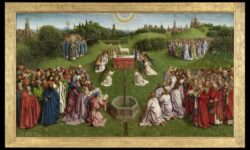
View
1432
Middle Ages
The Adoration of the Mystic Lamb is one of the most famous paintings in the history of Western art. Hubert and Jan van Eyck made the monumental triptych between 1424 and 1432.
The Battle of Gavere
The Burgundians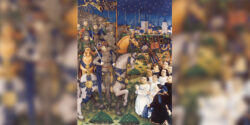
View
1453
Middle Ages
On 23 July 1453 Ghent militias advanced on Gavere to attack the army of the Duke of Burgundy. When their own supply of gunpowder threatened to blow up, the men of Ghent scattered.
The Bayard Steed of Dendermonde
Processions and Parades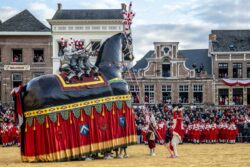
View
At the latest 1460
Middle Ages
Every ten years a gigantic wooden horse trundles through the streets of Dendermonde: the Bayard Steed. On its back sit the four ‘Heemskinderen’, played by four brothers born in Dendermonde.
The Mechelen Choir Book
Polyphonic Music in the Low CountriesView
c. 1515
Early Modern Period
The Mechelen Choir Book is one of the most beautiful and best-preserved music manuscripts from the 16th century. It was produced in around 1515 in the workshop of Petrus Alamire in Mechelen.
Erasmus
HumanismView
c. 1469
- 1536
Early Modern Period
Erasmus was one of the most influential European thinkers of the 16th century. He wrote on the upbringing of children and education and sharply criticised the church and those in power.
Pedro de Gante
Europeans in a ‘New World’View
c. 1480
- 1572
Early Modern Period
In 1523 a Franciscan from Ghent travelled to Tenochtitlan, present-day Mexico City. His name was Pieter van der Moere, but he became known under his Spanish name of Pedro de Gante.
Mad Meg
Pieter Bruegel the Elder and the RenaissanceView
1563
Early Modern Period
A mad woman with armour and sword leads a robber band of women among the most grotesque monsters towards the open mouth of hell: in 1563 Pieter Bruegel the Elder painted a panel that still speaks to the imagination.
The Iconoclastic Fury
Civil War in the Low Countries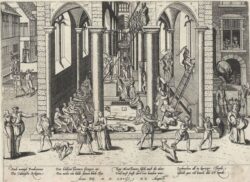
View
1566
Early Modern Period
The divisions between Protestants and Catholics led to an iconoclastic fury, which in 1566 went through the Low Countries like a shockwave.
Simon Stevin
A Scientific LensView
1548
- 1620
Early Modern Period
The versatile scientist Simon Stevin made important contributions to mathematics and physics, logic and language study, but as an engineer also found solutions for all kinds of practical problems.
Cathelyne Van den Bulcke
Witch Trials in Europe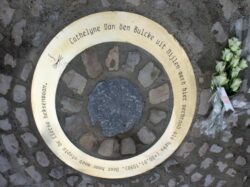
View
?
- 1590
Early Modern Period
On 20 January 1590 Cathelyne Van den Bulcke was burnt at the stake in the market-place of Lier. She was one of the many ‘witches’ who between the 15th and 18th century were victims of popular superstition.
The Adoration of the Magi
Rubens and the Baroque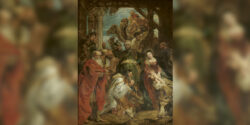
View
1624
Early Modern Period
In 1624 Peter Paul Rubens painted a monumental work for the high altar of Saint Michael’s Abbey in Antwerp. The subject was a familiar Biblical scene: the visit of the three kings to the newborn Christ-child.
The Bombardment of Brussels
Wars in the Spanish-Habsburg Netherlands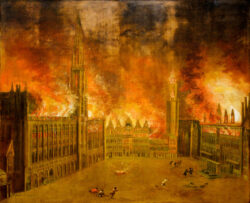
View
1695
Early Modern Period
From 13 to 15 August 1695 the French army bombarded the city of Brussels with a constant barrage of cannon and mortar fire. The military use of the action was secondary, sowing terror was the real aim.
Empress Maria Theresia
Enlightenment in Europe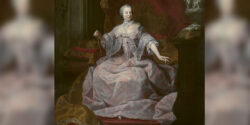
View
1717
- 1780
Early Modern Period
Members of the Habsburg dynasty ruled for more than six centuries over large parts of Europe. In all that time only one woman sat on the throne: Maria Theresia. For forty years she ruled (with her other domains) over the Austrian Netherlands.
The Mule Jenny
The Advent of Machines and Factories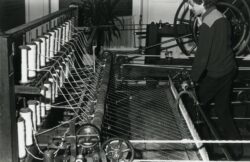
View
c. 1800
Modern Period
The Mule Jenny caused a true revolution in the cotton industry: the machine could spin cotton almost two hundred times faster than a traditional spinning wheel. No wonder that the British tried to keep their invention secret as far as possible.
The Napoleonic Code
The French Period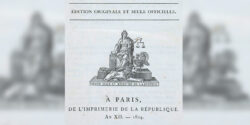
View
1804
Modern Period
Kilometres and centilitres, the land registry and the status of notary: things that we take for granted today, come from the period of French rule. The Civil Code – the rules that govern the mutual interaction of Belgian citizens – also dates from the French period.
A Liberal Constitution
Belgium IndependentView
1830
- 1831
Modern Period
With the Belgian Revolution of 1830 the bourgeoisie gave expression to its aspiration for a national state with a liberal regime. That was embodied in the constitution which was approved in 1831 and remained unchanged for almost 140 years.
The First Train Journey
The Railway Opens Up the CountryView
1835
Modern Period
On 5 May 1835 three steam trains left Groendreef station in Brussels. On board were nine hundred guests, spread over thirty carriages. When they arrived in Mechelen just over an hour later, a huge popular celebration erupted.
The Lion of Flanders
Hendrik Conscience and the Flemish Movement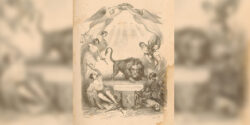
View
1838
Modern Period
Why does the Flemish Community celebrate on 11 July, why does the Flemish anthem honour a proud lion and why does the same animal decorate the Flemish flag? It all dates back to the success of one book: De Leeuw van Vlaenderen (the Lion of Flanders) by Hendrik Conscience.
The Potato Crisis
‘Poor Flanders’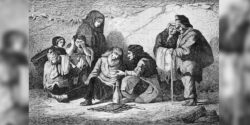
View
1845
- 1847
Modern Period
Between 1845 and 1847 a hitherto unknown fungal disease destroyed the potato crop in large parts of North-West Europe. This resulted in the last great European famine in peacetime.
The Opening-Up of the Scheldt
Antwerp, Gateway to the World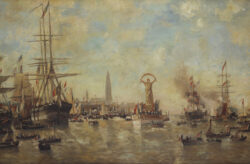
View
1863
Modern Period
On 1 and 2 August 1863 Antwerp celebrated: the city lit with lanterns, streets crowded with people, fireworks on the quays, decorated boats everywhere on the Scheldt. From now on no toll was payable to the Netherlands for the right to sail up the Scheldt.
Emilie Claeys
The ‘Social Question’ in the 19th CenturyView
1855
- 1943
Modern Period
In the nineteenth century working conditions in the Ghent spinning mills were particularly bad. Women workers had to make do with a wage that was even lower than the man’s starvation wages and they were often victims of sexual abuse.
Christ’s Entry into Brussels in 1889 by James Ensor
Innovation in the Visual Arts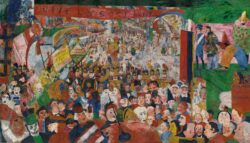
View
1889
Modern Period
Christ’s entry into Brussels in 1889 is the most ambitious work of the Ostend artist James Ensor (1860-1949). The painting illustrates the new course taken by Belgian art at the end of the 19th century.
Bloodbath in Leuven
Fighting for the Vote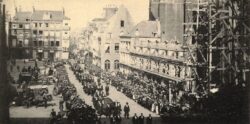
View
1902
Modern Period
In the evening of 18 April 1902 demonstrating workers marched through Leuven. They were protesting because parliament had just rejected the one man-one vote system.
Marie Belpaire
Girls Go to SchoolView
1853
- 1948
Modern Period
In the 19th century educational opportunities for women from all levels of society were extremely restricted. The Catholic writer Marie Belpaire made it her life’s work to remedy the situation.
Three Crowing Cocks
The Flemish Movement and the Language Struggle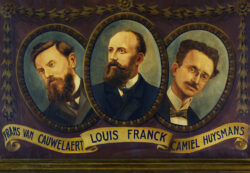
View
1910
Modern Period
On 18 December 1910 a meeting in Antwerp caused quite a stir. To a boisterous audience three members of parliament solemnly promised like three cocks to wake the country with their crowing. Their aim: to convince everyone that Flanders had a right to a Dutch-language university.
The Tour of Flanders
The Land of the Road RaceView
1913
Modern Period
‘Flanders’ finest’: with that expression Flemings are not referring to a person, a landscape or a painting, but to a cycle race.
Paul Panda Farnana
Congo, Conquered and ColonisedView
1890
- 1930
Modern Period
Paul Panda Farnana was the first Congolese intellectual to openly criticise colonialism.
Grieving Parents by Käthe Kollwitz
The First World War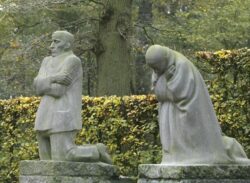
View
1914
- 1918
Modern Period
Treurend ouderpaar van Käthe Kollwitz op de begraafplaats van Duitse soldaten in Vladslo geeft treffend uitdrukking aan het universele leed van de Eerste Wereldoorlog.
Multicultural Mining Villages
Coal in Limburg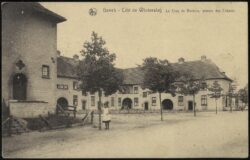
View
1901
- 1992
Modern Period
The discovery of coal in Central Limburg in 1901 heralded a new era for the region. There suddenly appeared in the quiet Limburg Campine derricks, roads, railway lines and new estates.
Jozef Cardijn’s Youth Movement
Pillarisation and SecularisationView
1920s –
Modern Period
Jozef Cardijn, a priest from Halle, was indignant at the wretched lot of young workers, and so after the First World War he founded the Young Christian Workers.
Our Cookbook
Culinary CanonsView
1927
Modern Period
In 1927 there appeared on the initiative of the Farmers’ Wives’ Federation the first edition of Ons Kookboek (Our Cookbook). This kitchen guide grew into one of the most successful recipe books and set the standard in many Flemish kitchens.
The Yser Tower
The Legacy of the First World War
View
1930
Modern Period
In 1928 a fifty-metre-high tower rose in Diksmuide on the left bank of the Yser, a monument to pro-Flemish soldiers who died in the First World War. The Yser Tower became one of the most controversial monuments in Flanders.
The Drama of Meensel-Kiezegem
The Second World War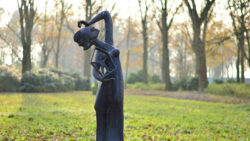
View
1940
- 1945
Modern Period
On 11 August 1944, two months after the Allied landings in Normandy, German soldiers and Flemish collaborators surrounded the Flemish-Brabant village of Meensel-Kiezegem.
The Dossin Barracks
The Persecution of the Jews during the Second World War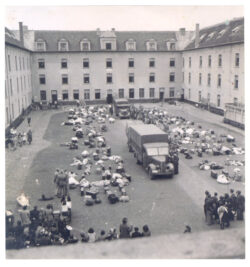
View
1940
- 1945
Modern Period
In 1942 in the occupied territories the Nazis started on the deportation of Jews to extermination centres in the Third Reich. In Belgium they used the Dossin barracks in Mechelen as an assembly camp.
The Social Pact
Social Security and the Welfare State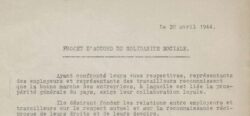
View
1944
Present Period
On 20 April 1944, while the war was still raging, a number of trades union leaders and employers signed the ‘Preliminary Draft Declaration on Social Solidarity’.
Ribbon Development
Spatial Planning in Flanders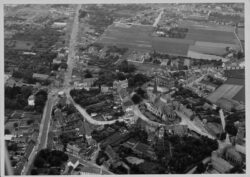
View
1948
Present Period
Cobbled roads that wind from village centre to village centre, flanked on either side by villas, businesses, here and there a meadow and especially lots of improvised buildings: that view has been typical for decades of densely populated Flanders.
Paula Sémer
Television as a Window on the WorldView
1925
- 2021
Present Period
On Saturday 31 October 1953 a few hundred families watched the very first Flemish television broadcast. The news and weather forecast were followed by Drie dozijn rode rozen (Three Dozen Red Roses), a comedy with Paula Sémer.
The Oostakker Poems by Hugo Claus
Artistic Renewal after 1945View
1955
Present Period
The collection The Oostakker Poems by Hugo Claus was acclaimed in 1955 as a high point in Dutch-language literature.
The Pill
Sexual Revolution and Women’s Rights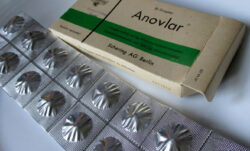
View
1961
Present Period
The invention of reliable contraception, such as the pill, enabled people from the 1960s on to prevent pregnancy effectively. That not only heralded a sexual revolution, but also contributed towards the emancipation of women.
Le plat pays of Jacques Brel
French-Language Culture in Flanders
View
1962
Present Period
In 1962 Jacques Brel sang of the North Sea, the Scheldt and the wet, grey skies in Le plat pays. The song remains one of the most beautiful odes to the Flemish landscape.
The Establishment of the Language Border
Belgium Becomes a Federal State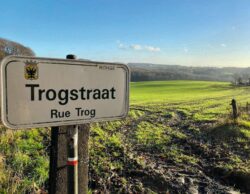
View
1962
- 1963
Present Period
The political significance of the Dutch-French language border had for a long time remained limited. However, the aspiration of the Flemish movement to achieve a monolingual Flanders made the language border a subject of debate.
Steel in Flanders
Economic Growth in the Sixties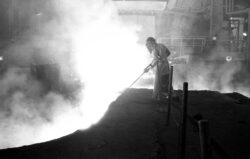
View
1967
Present Period
In 1967 the first steel sheets came off the rollers of the new Sidmar steel plant in Zelzate, the present ArcelorMittal. Steel had never before been produced in Flanders.
Rock Werchter
Festival Culture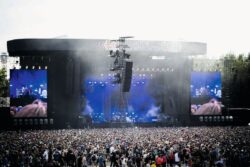
View
1975
Present Period
In the summer of 1975 in rural Werchter two bands performed to an audience of a few hundred. The initiative of the local Chiro youth group laid the foundation for one of the biggest music festivals in Europe.
The Euro
European Integration
View
2002
Present Period
At New Year 2002, just after midnight, long queues formed at cash machines all over the country. For the first time euro notes could be withdrawn.
Same-Sex Marriage
LGBTQ+, from Discrimination to Emancipation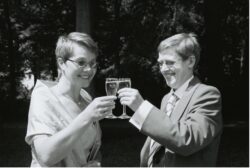
View
2003
Present Period
They rewrote history with a simple ‘I do’. On 6 June 2003 two brides married each other in Kapellen. It was the first marriage between lesbians in Belgium. A week later two men married for the first time.
Goesting
A Standard Language for Flanders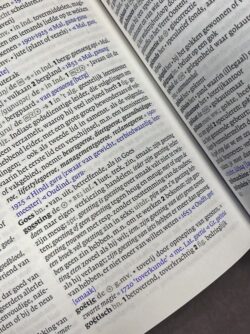
View
2004
Present Period
Someone with ‘goesting in een croque-monsieur’?. It must be a Fleming.
The World in Flanders
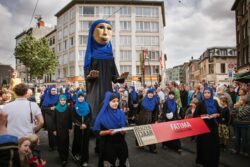
View
2012
Present Period
Every year in the fourth week of September the giants of Borgerhout parade, surrounded by musicians and floats.
View